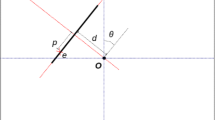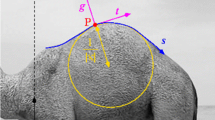Abstract
This paper’s main contributions are three-fold. Firstly, it is shown that the two existing template matching-like definitions of the Hough transform in the literature are inadequate. Secondly, an, inherent probabilistic aspect of the Hough transform embedded in the transformation process from image space to parameter space is clarified. Thirdly, a new definition of the Hough transform is proposed which takes into account both the intersection scheme between the mapping curve (or mapping surface) and accumulator cells and the inherent probabilistic characteristics.
Similar content being viewed by others
References
Princen J, Illingworth J, Kittler J. A formal definition of the Hough transform: properties and relationships.Journal of Mathematical Imaging and Vision, 1992, 1: 153–168.
Bergen J R, Shvaytser Haim. A probabilistic algorithm for computing Hough transforms.Journal of Algorithms, 1991, 12: 639–656.
Hough P V C. A method and means for recognizing complex patterns. U.S. Patent 3, 069, 654, 1962.
Ballard D H. Generalizing the Hough transform to detect arbitrary shapes.Pattern Recognition, 1981, 13(2): 111–122.
Maitre H. Contribution to the prediction of performances of the Hough transform.IEEE T-PAMI, 1986, 8(5): 669–674.
Duda R O, Hart P E. Use of the Hough transform to detect lines and curves in pictures.CACM, 1972, 15(1): 11–15.
Hu Z Y, Destiné J. Parameter probability density analysis for the Hough transform.Signal Processing, 1993, 33(2): 159–168.
Cohen M, Toussaint G T. On the detection of structures in noisy pictures.Pattern Recognition, 1977, 9: 95–98.
Kiryati N, Eldar Y, Bruckstein A M. A probabilistic Hough transform.Pattern Recognition, 1991, 24(4): 303–316.
Shaked D, Yaron O, Kiryati N. Deriving stopping rules for the probabiistic Hough transform by sequential analysis.Computer Vision and Image Understanding, 1996, 63(3): 512–526.
Xu L, Oja E. Randomized Hough transform: Basic mechanisms, algorithms, and computational complexities.CVGIP: Image Understanding, 1993, 57(2): 131–154.
Kalviaihen H, Hirvonen P, Xu L, Oja E. Probabilistic and non-probabilistic Hough transforms: Overview and comparisons. 1995, 13(4): 239–252.
Leavers F V. The dynamic generalized Hough transform. InProc. First European Conference on Computer Vision, 1990, pp.592–594.
Leavers F V. The dynamic generalized Hough transform: Its relationship to the probabilistic Hough transform and an application to the concurrent detection of circles and ellipses.CVGIP: Image Understanding, 1992, 56(3): 381–398.
Ben-Tzvi D, Sandler M B. A combinatorial Hough transform.Pattern Recognition Letters, 1990, 11: 167–174.
Hu Z Y, Ma S D. The performance prediction of the Hough transform.Journal of Computer Science & Technology, 1997, 12(1): 49–57.
Hu Z Y, Ma S D. Three conditions of a good line parameterization.Pattern Recognition Letters, 1995, 16: 385–388.
Author information
Authors and Affiliations
Corresponding author
Additional information
This work was supported by the National ‘863’ Hi-Tech Program and the National Natural Science Foundation of China.
Hu Zhanyi was born in 1961. He received the B.S. degree in automation from the North China University of Technique in 1985, the M.S. and Ph.D. degrees in computer science from the University of Leige, Belgium, in 1988 and 1993, respectively. Now, he is a Professor in the National Laboratory of Pattern Recognition (NLPR), Chinese Academy of Sciences (CAS). His research interests include robot navigation, feature extraction, and active vision.
Wang Wei received the B.S. degree in computer science from Zhejiang University in 1994, the M.S. degree from the NLPR, CAS. His research interests include image processing, computer vision and robot vision.
Yang Yi received the B.S. degree in electrical engineering from Huazhong University of Science and Technology in 1995. He is now a M.S. candidate in the NLPR, CAS. His research interests include image processing, computer vision and robot vision.
Ma Sonde was born in 1946. He received the B.S. degree in automation from Tsinghua University in 1969, and the degrees of Docteur de 3 ieme cycle and of Docteur d’Etat from University of Paris VI in 1983 and 1986 respectively. From 1983 to 1984 he was an invited researcher in the Computer Vision Laboratory, University of Maryland. From 1984 to 1986 he was an invited researcher in the Robotic Vision Group of INRIA in France. Since 1986 he has been a Professor in the NLPR, CAS. His research interests include 3D computer vision, neural computing, realistic image synthesis and sensor based robot control.
Rights and permissions
About this article
Cite this article
Hu, Z., Wang, W., Yang, Y. et al. A new definition of the Hough transform. J. of Comput. Sci. & Technol. 13, 385–392 (1998). https://doi.org/10.1007/BF02948496
Received:
Issue Date:
DOI: https://doi.org/10.1007/BF02948496




